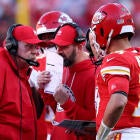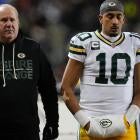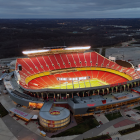
Brandon Carr reunites with Cowboys in 2020: Unique strategy in play as veteran opts to join practice squad
Mike McCarthy has unveiled quite the magic trick in Dallas

Abracadabra. The NFL deadline for initial roster cut-downs to take teams from 80 players to the mandatory count of 53 has now come and gone, and the Dallas Cowboys were unusually Belichickian in how they maneuvered this past weekend. There was a bit of magic in their decisions, opting to release veterans they knew wouldn't hit waivers (e.g., linebacker Joe Thomas) to make room for incoming signings and re-signings of others they released who cleared waivers (e.g., cornerback C.J. Goodwin, linebacker Justin March, etc.), knowing they'd add Thomas back to the roster anyway. The most intriguing trick up their sleeve by far, however, came by way of reuniting with Brandon Carr, who the club signed on Sunday.
He wasn't signed to the active roster though, but instead the practice squad, and there are many reasons why that's interesting. As a 12-year veteran in the NFL, Carr has long no longer qualified for any team's practice squad, nor has he ever landed on one. So why did the 34-year-old decide to subject himself to a 16-man unit unlikely to see the field unless there's injury or poor play at his position?
Simple. It's because that's not the original plan for Carr, a source tells CBS Sports of the signing.
Thanks to a new round of practice squad rules in 2020, not only is the unit boosted to a 16-man tally, but two players each week can be added to the 53-man count to carry 55 players on game day. This means Carr is a candidate in Week 1 and beyond to be one of those two players, who can then be slid back down to the practice squad the next day without first being released. Once the player reaches the max of two activations, he must be released in order to be placed back on the practice squad, which is where things get really spicy for the Cowboys' second stretch with Carr.
As a vested veteran (four accrued seasons or more), Carr won't hit waivers if the Cowboys are forced to release him down the line with the goal of placing him back on the practice squad. So, technically, he could immediately re-sign with the Cowboys the day following his release, and the team can rinse-and-repeat this strategy multiple times in 2020 -- providing not only a phenomenal veteran presence in the locker room, but a starter-caliber defensive back who they're looking to "fully" convert to safety that can also play cornerback as needed.
One caveat behind the caveats is that Carr (or any practice squad player) can be activated due to a COVID-19 injury at their respective position and it won't count toward the maximum two promotion limit, which is also key to note.
That's not all, though.
As far as strategy goes, adding Carr to the practice squad keeps his cost to the team minimal, seeing as he's not on an active player's salary, and is expected to earn only $12,000 per week with no guaranteed money in 2020. Should (or rather when) he's moved up to the active roster for any prospective game day, his salary will be adjusted to 1/17th of the minimum annual salary for a player with 12 accrued seasons -- which amounts to $60,588.24 -- a nice bump in pay. The impact of deploying such a strategy for Carr will mostly be of no consequence to the Cowboys salary cap, and yet there are even more benefits to the move, such as the likelihood of Carr being named a protected player on the practice squad.
To put it plainly, usually each player on the Cowboys practice squad can be poached by another team, but that new team has to put said player on their team's active roster -- where he must remain for at least three weeks -- if the player agrees to leave his current team. In 2020, however, the NFL allows a club to protect four players from being poached, and you can probably pencil in Carr as someone the Cowboys won't allow to field any offers.
His first stint with the team, in 2012 through 2016, was mostly viewed as unimpressive by those who weighed his contract against his lack of interceptions (while not taking into account the reason he lacked INTs, i.e., coaching and lack of a dynamic pass rush), but this is a chance for Carr to truly help the Cowboys in their journey to potentially appearing in Super Bowl LV. He no longer needs to be the marquee cornerback in Dallas, or a cornerback at all, considering they need assistance at safety and he played well in that role on the back end of his stay in Baltimore.
And, in the end, if the incumbent safeties play well, Carr is simply a cost-effective option on emergency standby who helps galvanize the locker room each week. There's also a chance he beats out a younger guy and gets promoted to the active roster for good this year, which would potentially see him paid a maximum salary of $1.03 million ($60,588 x 17), roughly $2.72 million less than what they were initially willing to pay a now-released Ha Ha Clinton-Dix.
In other words, this isn't just flexibility -- it's contortionist.
For what it's worth, the addition of Carr also doesn't negate nor does it bolster any pending any interest in Carr's former teammate, Earl Thomas, as McCarthy and the Joneses continue to hash out if the controversial All-Pro is worth the risk.
The Cowboys have basically found a way to add depth at a position(s) of need without sacrificing a roster spot, with someone familiar with the organization who also hasn't missed a single start in 198 games -- making him one of the most durable players in NFL history -- and who has agreed to be a chess piece for them as Mike McCarthy pulls a few rabbits out of his hat to begin the 2020 season.
Voila.


















